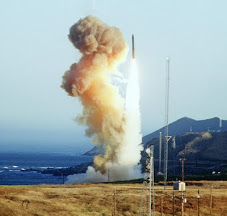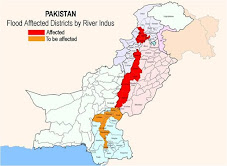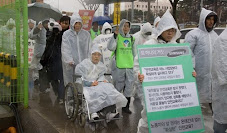Text Informed by
Bruce Gagnon on July 30, 2009
Foreign Policy In Focushttp://www.fpif.org/fpiftxt/6295Pushing South Asia Toward the BrinkBy Zia Mian | July 27, 2009The contradictions and confusions in U.S. policy in South Asia were
on full display during
Secretary of State Hilary Clinton's recent
visit to India. U.S. support for India, which centers on making
money, selling weapons, and turning a blind eye to the country's
nuclear weapons, is fatally at odds with U.S. policy and concerns
about Pakistan.
By enabling an India-Pakistan arms race, rather than focusing on resolving the conflict and helping them make peace, the United States is driving Pakistan toward the very collapse it fears.America's New IndiaIn an op-ed in The Times of India just before the start of her visit,
Clinton laid out U.S. interests in India.
The first item on Clinton's list was "the 300 million members of India's burgeoning middle class," that she identified as "a vast new market and opportunity."The emerging Indian middle class is large - for comparison, the
current total U.S. population is also about 300 million - and greedy
for a more American lifestyle.
But the focus on India as fundamentally a market for U.S. goods and services, and a source of cheap labor for U.S. corporations, marks a remarkable shift. The
United States and other western countries have traditionally seen
India as the home of the desperately poor, deserving charity and
needing development. But no more.
Clinton's article made no mention of India's poor, which the World Bank recently estimated as including over 450 million people living on less than $1.25 a day.India is also seen as a new emerging power of the 21st century, one
that can be an ally of the United States and help it balance and
contain the rise of China.
Under the Bush Administration, in 2004, the U.S. and India signed an agreement called the "Next Steps in Strategic Partnership." To make India a fitting strategic partner, a senior State Department official later explained the U.S."goal is to help India become a major world power in the 21st century," and left no doubt what this meant, saying "we understand fully the implications, including military implications, of that statement."India is seeking both to modernize and expand its military forces.
It has dramatically increased its military budget, up over 34% alone this year. India now has the 10th-highest military spending in the world. It's becoming a major market for U.S. arms sales. U.S. weapons
makers Lockheed Martin and Boeing have already racked up deals worth
billions of dollars. But the real bonanza is still to come.
India is said to be planning to spend as much $55 billion on weapons over the next five years.But the big news of the Clinton visit was the announcement of an India-U.S. Strategic Dialogue. This will include an annual formal
meeting of key officials, co-chaired by the secretary of State and
India's external affairs minister, and including on the U.S. side the
secretaries of Agriculture, Trade, Energy, Education, Finance, Health
and Human Services, Homeland Security, and others. But given the
difference in the power and range of interests of the two states,
this will be no dialogue of equals. The process is intended to align
Indian interests and policies in a wide range of areas with those of
the United States.
Nuclear IndiaIn her press conference with India's minister of external affairs,
Clinton said,
"We discussed our common vision of a world without nuclear weapons and the practical steps that our countries can take to strengthen the goal of nonproliferation." But there was no mention here of India's nuclear buildup, or of the United States asking India to slow down or to end its program. In fact, one would never guess
from Clinton's remarks that India even had a nuclear weapons program.
She seemed interested only in the prospect of U.S. sales of nuclear reactors to India worth $10 billion or more.India is one of perhaps only three countries still making material for new nuclear weapons. The others are Pakistan and Israel (with North Korea threatening to resume production). India is building a fast-breeder reactor that is expected to begin operation in 2010 and is outside International Atomic Energy Agency safeguards. It could increase three- to five-fold India's current capacity to make plutonium for nuclear weapons.India seeks to become a major nuclear power.
On July 26, it launched its first nuclear-powered submarine. India plans to deploy several of
these submarines.
Last year, it carried out its first successful underwater launch of a 700 kilometer-range ballistic missile, Sagarika, intended for the submarine. India joins the United States, Russia, the United Kingdom, France, and China in the club of those owning such nuclear-armed, nuclear-powered submarines. Israel is believed to have nuclear-armed cruise missiles on diesel powered submarines.India is also developing an array of land-based missiles. In May
2008, it tested the 3,500 kilometer-range
Agni-III missile, which was
subsequently reported to have been approved for deployment with the
army, and is working on a missile with a range of over 5,000
kilometer. In November 2008, India also tested a 600 kilometer-range
silo-based missile, Shourya. In 2009, India carried out several tests
of its
cruise missile, Brahmos, which the army and navy are inducting
into service.
The U.S. silence on India's nuclear weapons and missile programs is all the more telling, given that it was the Clinton administration that proposed United Nations Security Council resolution 1172. In 1998, this unanimous Security Council resolution called on India and Pakistan to "immediately stop their nuclear weapon development programs, to refrain from the deployment of nuclear weapons, to cease development of ballistic missiles capable of delivering nuclear weapons, and any further production of fissile material for nuclear weapons." The Bush administration ignored it. It seems the Obama
administration will too.
Pakistan v. IndiaPakistan was noticeable for its near absence from Clinton's agenda in India. It came up only in the context of the need to fight terrorism.
Forgotten was the brute fact that India and Pakistan are straining
harder than ever in their nuclear and conventional arms race.
A Pakistani diplomat responded to the Clinton visit to India by telling The Washington Post that "What Hillary is doing there is probably again going to start an arms race." This race drives Pakistan toward collapse, the very thing the United States fears.Pakistan is buying U.S. weapons as fast as it can, some paid for with
U.S. military aid, with arms sales agreements worth over $6 billion
since 2001, including for new
F-16 jet-fighters. China, an old ally,
is also supplying the country with jet fighters and other weapons.
Pakistan is also boosting its nuclear program. It's building two new
reactors to make plutonium for nuclear weapons. It continues to test
both ballistic missiles and cruise missiles to carry nuclear weapons.
The principal U.S. concern about Pakistan, aside from the country
falling apart and its nuclear weapons falling into the hands of
Islamists, is the war against al-Qaeda and the Taliban in Afghanistan
and in the border areas of Pakistan. It has been telling Pakistan to
focus its military forces and strategic concerns on this battle,
which requires moving more soldiers away from the border with India.
The generals who command Pakistan's army were bound to resist such a
redeployment. They worry about the new U.S.-India strategic
relationship, and what it may mean for them when the war on the
Taliban is over and the United States no longer needs Pakistan.
The Pakistani army, which rules the country even when civilians are
in office, will not easily shift its view of India. The army and
those who lead it see the threat from India as their very reason for
being. The army has grown in size, influence, and power, to the point
where it dwarfs all other institutions in society and would lose much
if there was peace with India. But there is a personal dimension as
well. The partition of the subcontinent 62 years ago that created
Pakistan is in the living memory of many who make decisions in
Pakistan.
General Pervez Musharraf, who was chief of army staff before he seized power in 1999 and ruled for nine years, was born in India before partition. General Musharraf, along with the current chief of army staff, General Kayani, and others in Pakistan's high command, fought as young officers in the 1971 war against India. The war ended with Pakistan itself partitioned, as East Pakistan became the independent state of Bangladesh, with India's help, and 90,000 Pakistani soldiers captured by India as prisoners of war.As Graham Usher notes in the new issue of the Middle East Report,
before becoming president,
Barack Obama seemed to understand that resolving the conflict between India and Pakistan was critical to dealing with the problems in Afghanistan and with the Taliban. In
2007, Obama claimed
"I will encourage dialogue between Pakistan and India to work toward resolving their dispute over Kashmir and between Afghanistan and Pakistan to resolve their historic differences and develop the Pashtun border region. If Pakistan can look toward the
east with greater confidence, it will be less likely to believe that
its interests are best advanced through cooperation with the
Taliban." There is little evidence that this view has yet informed
U.S. policy.
The Reality of PakistanIn their rush to make money and to preserve American power in the
world by crafting an alliance with India, U.S. policymakers seem to
have averted their eyes from the reality that stares them in the face
in Pakistan.
In March 2009, the Director of National Intelligence summed up the situation in Pakistan: The government is losing authority in parts of the North-West
Frontier Province and has less control of its semi-autonomous tribal
areas: even in the more developed parts of the country, mounting
economic hardships and frustration over poor governance have given
rise to greater radicalization.Economic hardships are intense, and
the country is now facing a major balance of payments challenge.
Islamabad needs to make painful reforms to improve overall
macroeconomic stability. Pakistan's law-and-order situation is
dismal, affecting even Pakistani elites, and violence between various
sectarian, ethnic, and political groups threatens to escalate.
Pakistan's population is growing rapidly at a rate of about 2 percent
a year, and roughly half of the country's
172 million residents are
illiterate, under the age of 20, and live near or below the poverty
line.
Things have worsened since then. The Taliban is now seeking to escape
U.S. drone attacks and major assaults by the Pakistan army in the
Tribal Areas by taking refuge in the cities.
There are already no-go areas in Karachi, Pakistan's largest city, where the Taliban controls the streets. Meanwhile electricity riots have exploded in cities
across the country, with mobs attacking public buildings, blocking
highways, and damaging trains and buses. Each day seems to bring news
of some new failure of the state to provide basic social services.
The Obama administration believes that an increase in U.S. aid to
Pakistan can help solve the problem.
The Kerry-Lugar bill (the Enhanced Partnership with Pakistan Act) approved by the Senate in June would triple economic aid to Pakistan to $1.5 billion a year for five years. But as the Congressional Research Service noted in its
recent report on Pakistan, the United States has given Pakistan about
$16.5 billion in "direct, overt U.S. aid" up to 2007. More of the
same offers little hope for change.
A basic reordering of U.S. priorities in South Asia is long overdue.
The first principle of U.S. policy in the region should be to do no
more harm. This means it has to stop feeding the fire between India
and Pakistan. Only an end to the South Asian arms race can begin to
undo the structures of fear, hostility, and violence that have
sustained the conflict in the subcontinent for so long. The search
for peace may then have at least a chance of success.
Zia Mian is a physicist with the Program on Science and Global Security at the Woodrow Wilson School of Public and International Affairs at Princeton University and a columnist for Foreign Policy In Focus.Global Network Against Weapons & Nuclear Power in Space
PO Box 652
Brunswick, ME 04011
(207) 443-9502
http://www.space4peace.orgglobalnet@mindspring.com
http://space4peace.blogspot.com (Blog)

 rg/English/8504
rg/English/8504





















![[URGENT PLEA: In Update] EMERGENCY in GANGJEONG Since AUG. 24, 2011](https://blogger.googleusercontent.com/img/b/R29vZ2xl/AVvXsEiQvpaNf6EePZVucu97_JphYsFS5IgumnSiA4YAmen1PZcim6vMmW7XjZ7J6nLh-Cu36mwBN5n1evrA3ey0vYMpwlAGsgnSFggv6a1w4Qx9BvvqOB0hy0BIcBkL2Exfs3zIxBsBuDGa1kzg/s227/jejusit.jpg)



![[Solidarity from Japan for the Jeju] 253 individuals and 16 groups/organizations](https://blogger.googleusercontent.com/img/b/R29vZ2xl/AVvXsEivji7100kBkr0hzvqYfh4IBBilkZ6XgDIg89jOxS6kTssxsVKC6Wm-fZbKOEsiy3zcO-9gW6GHspD5R_2C9WsGx5S1Z5VPj_OVRF7H6dxdaT0S-2H1eqsDsYvIwOV26VscxTHnKmP5iZmh/s227/jeju_12_10j.jpg)

![[Translation] Korean organizations' statement: Immediately cancel the joint ROK-US drill Nov 26](https://blogger.googleusercontent.com/img/b/R29vZ2xl/AVvXsEgfKDMo-qyEjm5asUtHlREyJY_5Ou-2tyB8SH6aUxiViRbbKR-8W_rirFiGp5DYSoD_KaeNOPMWR0af0ZPUIbJKmR89ImDvADHsGAIqsJVBvJNBEIl5wLd3G_zhPDW3Z2SxsHXadOsXe8st/s227/1.jpg)
![HOT! [Hankyoreh Hani TV] Beneath the Surface: the investigation into the sinking of the Cheonan](https://blogger.googleusercontent.com/img/b/R29vZ2xl/AVvXsEh80rL3Qv9GnfHSqbYMfivdqX5gZN-1O_VQj3A_Gk3yjWdybHwJCsprA3l6cEQB0cYCP2oNeaLo2ohLGIy0Uqqkv_fRkBevGJ2f-qkKD5eP1ZGsKeQ-r-jHUUb79WvucIN7hpEtXza4xXCL/s227/HaniTV+Cheonan.gif)



![[Translation]Statement against illegal inspection and unjust lay-off by the Kunsan USAFK!(Nov_2010)](https://blogger.googleusercontent.com/img/b/R29vZ2xl/AVvXsEg3JlQ-lreusCIJo5Yv2e3ZrRwrSMUE7UQxlrDVjmBehl0Pa24QZIAbZ5vUpgnnExbkKL9PdCwxVYSHWJkr_XK0FM4EhU3CMFhqfborVNu_p4v3bEFpNm3ia-aEHnvMMuEBI27aB7_BETuJ/s227/gunsan+protest.gif)
![[Translation] Korean organizations' statement against dispatching special force to the UAE on Nov.](https://blogger.googleusercontent.com/img/b/R29vZ2xl/AVvXsEiU7TNhTDLLwZkKP0Z78JsCZKp6je-QSFll3_ThmLES_y_nPLXEzeakrsZXoNxhN5blopEhy6xGV2tneJrniPdTR-JvOQMmSLr_HhlucxFvbusxk4oKvvMO2laBOHSIkB9OOeOxrQlqCA0O/s227/antiwarpeace.jpg)
![[Translation] Stop, Joining MD!: South Korean activists' statement and writing on Oct. 25, 2010](https://blogger.googleusercontent.com/img/b/R29vZ2xl/AVvXsEggGIHVei8j7LCJPJB5HIrspd942q436daNTquP-pFd45Cl70Ml_1JFiFDHgKu6FcoqNgFVKIFqjeuSPau2k_BwGHhx0cqFFL2-4ybZSTlmua0_AsERBtKYQa7jZk7uNj41LX6rj2vksHbo/s227/StopMD.jpg)
![[In Update] People First, NO G-20 (Nov. 6 to 12, Korea)](https://blogger.googleusercontent.com/img/b/R29vZ2xl/AVvXsEhZl8VTqeL7o2ndliGIE-sZFCikbTgfB9KCc3AtZvDaYijBBEhdfultMEOpyrCaD5gzpH8mqfWjU20KXMbSUl-5KM7yQeHU6z3BWV8tiOy4UKaCudz9VKWoi5x58xdC_gQpJTjkR5u7O9xf/s227/left21_G20.jpg)
![[International Petition] Stop US helipad plan in Okinawa to save great nature](https://blogger.googleusercontent.com/img/b/R29vZ2xl/AVvXsEihgYmdb0N8ViPvTFC_5i-Psbt4eX_LnAUEOtZkUngv_pGvRyWag1r6W60NicLLyTgWq-sPT1hBxLY5SadEIVv5McfZQ5uIhe-W0VoflQNqojsYZjFW6AH-gB1jsmSDGnGuKIFk2UkvNbFG/s227/yanbaru_w.jpg)

![[Global Network] against the first launch of Quasi-Zenith Satellite, Japan, on Sept. 11, 2010](https://blogger.googleusercontent.com/img/b/R29vZ2xl/AVvXsEj2sYpfodDDMIA7qXwuda0DmKapxXFB479fDnn8RKy7QNZqz0VEvWucNd-DleZ37hWNXC-Z8QtaqtM37VuPwac5SgclJ9_khBBSWOedvm19MRXIP1j1kcWrK6EW5IFjQdEEY2h7E6xuyNvC/s227/Qzss-45-0_09.jpg)

![[In update] Some collections on the Koreans’ protests against the sanction & war on Iran](http://4.bp.blogspot.com/_gnM5QlRx-4c/TJMvke6t8zI/AAAAAAAAFO4/tamQ8LUnOOA/S227/No+Sanction+on+Iran.jpg)
![[Three International Petitions] to End the Korean war and peace treaty(or peace resolution)](https://blogger.googleusercontent.com/img/b/R29vZ2xl/AVvXsEhlohLVYtpCg7iMsZhNYY4hBbhTi2dIheHMHWLDph9X2y78cjgZV1LeSfUJeu80elhJm70Q9E059q72lK-spSPvsRG4bPuCDIytltJB9IH3mWt9OG98HqhnTsPakwhvNeoCFUgF1xoxQ2EZ/s227/border.jpg)



![[Collection of Documents] No Base Learning and Solidarity Program_Korea(June 14 to 20, 2010)](https://blogger.googleusercontent.com/img/b/R29vZ2xl/AVvXsEix_HzjToh3nNGHBc-_5gasq-ykcaZ6GInLixILmZVyRJ5xoeHCxWOyYd9fSM7bmnuFsjSrYOGEPnQOwB1Dcyo-sN4Pw0cFPhUtKig_qlVnGL1Wi82ClvPqbEPWYhJiqdNF0DyzLIBETMB9/s227/No-Base-banner.jpg)
![Site Fwd:[John Hines] A U.S. Debate coach’s research trip on the Issues of Korea](https://blogger.googleusercontent.com/img/b/R29vZ2xl/AVvXsEg8yRra0zNhKHN74Auqhd3Nx9tZ7BWCGflRJHGH4CfzBT_yjhZ8Nl9b3OZuLpYWJ2exsjmR0oVl-Qq_cf832p2VdmOZhUi-lCFzCNeDSyVtweX1lWZPC-RlHmDMLtilHwHjNFTenBiM4Fk4/s227/Jeju-Peace-Tour.jpg)


![[News Update] Struggle Against the Jeju Naval Base since Jan. 18, 2010](https://blogger.googleusercontent.com/img/b/R29vZ2xl/AVvXsEhKfSTRC5QKBBSFIq_m7QIqXdlbL4-gF5GJYn9Q-pN__k7sV7uxGDcLY5L8xmU7QuWuUhBT_GhG-URBPO80RT3AfWfDrWJr06h1hFuZC6ZBVKe4U6PS1Cd7Kr6olO8TYQtk13Drox7IS6ea/s226/scrum1.jpg)


![[Urgent] Please spread the Letter!: There was no Explosion! There was no Torpedo! (May 26, 2010)](https://blogger.googleusercontent.com/img/b/R29vZ2xl/AVvXsEhSd2yWZ3xGwnJQXB73z5FgXCqSosAoB9_33-GLYprOmLqjmvgSAQp1BYI7e4slK1FDxHRi9KK4um-OpDaj8QOkXwAScVAgvvq6-ehbDA-hbkr96wT9oHNNmWnBPv8GU4hoZp9X8F9AZBX4/s227/grounded.jpg)
![Text Fwd: [Stephen Gowans]The sinking of the Cheonan: Another Gulf of Tonkin incident](https://blogger.googleusercontent.com/img/b/R29vZ2xl/AVvXsEi_L6hB3RZ1MovTXHe0A8yn_RfgMALGR0kM6poBuGp809xwvHtB_-PGWtS_WpyPWatyd9lB2pPqL2gOLc4dTCEdJ9sMvxJWEdapl-mMLm7WHAsV-jVpgqarVh8XBtdz_0c-Vohdh3HtJahD/s227/lee-myung-bak.jpg)
![[Japan Focus]Politics in Command: The "International" Investigation into the Sinking of the Cheonan](https://blogger.googleusercontent.com/img/b/R29vZ2xl/AVvXsEiHmTo8v-uCJnabRhMdnBAkC9J3s5bb2JsDKiT5leJHwbK8IDJHxfJmqQ_C0Is_bPC6UGMf05CA0exF2y4r2x9RhFUHT0kjsKviaME_MZXKnq775UyYAdb7w2SAzE75XvBfHp1al2q6i3cf/s227/wen_jiabao_and_lee_myungbak.png)
![[Japan Focus] Who Sank the SK Warship Cheonan? A New Stage in the US-Korean War and US-China](https://blogger.googleusercontent.com/img/b/R29vZ2xl/AVvXsEiKSS5ULT5QBaMGYpXXqBMX9jtwLwMLuK469b6Ku72GTJYKUObzTANaPjZqvvpPzYMJgPF53sjhvhK3DVa88ipYlggsJageykXlkxY6s8TW05xcU-_vfhf-pACUoaWuFbT-fsU1qEhm_yIi/s227/buoy_map.gif)
![[Updated on 12/13/10] [Translation Project] Overseas Proofs on the Damages by the Military Bases](https://blogger.googleusercontent.com/img/b/R29vZ2xl/AVvXsEikADE6JovUNspQyZUWVMTLAQg7yQNqXpVUbqZPk8f4uc_1723_xm1Cco6WAmstQXVPnaJAcb1mZA8Ny_3xONT_f5uh8MNLPnUhtqdGgy3HCtC1Vbbz4Q0ZY1Cssu-4cJEVNdrvznbS5UzO/s227/missile.jpg)
![[International Petition] Close the Bases in Okinawa](https://blogger.googleusercontent.com/img/b/R29vZ2xl/AVvXsEhNpQiHklwFbWVlFK7GDFXnBSOOSFEj3Il-We-N3uTDldKiidL2NGZs7X_LtTnatzTo_r8CexRkFe8NhfxYqmgp1knEEslROTfNjI5_mSb57cdbhPkftvanveYBaevAD9xuKDGoIxiTwoSb/s227/2.jpg)

![[In Update]Blog Collection: No Korean Troops in Afghanistan](https://blogger.googleusercontent.com/img/b/R29vZ2xl/AVvXsEjjEmCRXSNAG7_QBxKWbdksmxoWR4nyAovQTTdR1G2AuXh0jxtqNkI9OmYgYWRoLAJShvtBvE840QXuBWSVh3u3zMYqkNAFX6OWy3m5Nur4HM7uNK-pKT1ycyApJp-VLyhIFRRcoisYAh0E/s226/No-Troops-to--Afghanistan.jpg)










